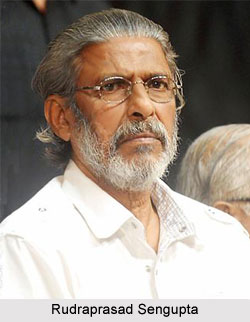 Rudraprasad Sengupta is a veteran person in the field of theatre and drama in Kolkata. Born in 1936 he was a famous product of college dramatics. He is a theatre personality from West Bengal, who has been able to create a name for him successfully. He married to Swatilekha Sengupta, renowned theatre actress.
Rudraprasad Sengupta is a veteran person in the field of theatre and drama in Kolkata. Born in 1936 he was a famous product of college dramatics. He is a theatre personality from West Bengal, who has been able to create a name for him successfully. He married to Swatilekha Sengupta, renowned theatre actress.
Early Life of Rudraprasad Sengupta
He studied at the Scottish Church College under University of Calcutta where he earned his Bachelor of Arts and M.A degrees in English literature respectively. With an MA in English from the University of Calcutta, he taught in a college and at Rabindra Bharati University, Kolkata.
Career in Theatre for Rudraprasad Sengupta
He joined the group Nandikar in 1961 to lead the dual life of actor and adaptor of plays. His adaptation of Pirandello`s Six Characters in Search of an Author i.e. `Natyakarer Sandhane Chhati Charitra` was the first major hit that Nandikar and Ajitesh Bandopadhyay as director achieved. Others, spanning Euripides, Brecht, Arthur Miller, and Arnold Wesker, made him the most consistent as well as prominent director in Bengali theatre working on foreign drama. He also developed as a fine actor. The father in Six Characters was his earliest success, but he did best of all in anti-heroic or somewhat malevolent roles, maturing into Miller`s older paternal characters in the 1990s. He married Nandikar`s talented leading lady, Keya Chakrabarti, who died prematurely of an accident in 1977.
Rudraprasad Sengupta`s independence and distinctive directorial style were established after Bandopadhyay left Nandikar in 1977. Since then he has led the group, ably assisted by his actress wife Swatilekha Sengupta. A long-term advocate of theatre as a career, he formed the Calcutta Repertory Theatre with Sombhu Mitra and other major actors of Kolkata in 1980. He produced Brecht`s Life of Galileo in Bengali, directed by Fritz Bennewitz, but the repertory was stillborn. Undaunted, Sengupta began the Nandikar Theatre Festival in 1983, in which troupes from all over India take part. The festival invited teams from Nepal, Bangladesh, and Pakistan too. Under Rudraprasad Sengupta, Nandikar conducts workshops to teach theatre to school students as well as slum dwelling children. He also wrote a book, Ibsen theke Albee i.e. `From Ibsen to Albee`.
In 1980, Rudraprasad Sengupta received quite a few awards, including the highest national recognition- Sangeet Natak Academy Award.




















